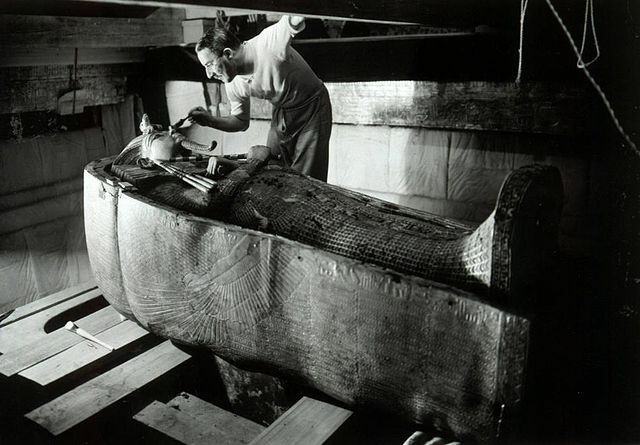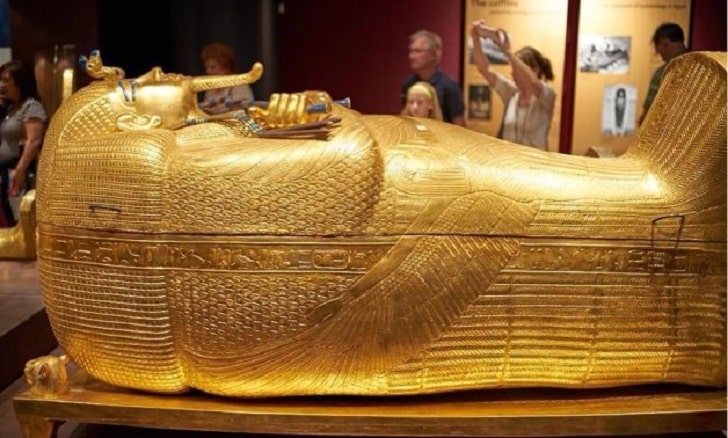On November 4, 1922, Howard Carter inserted a candle through a crack and illuminated the interior of the room he had just discovered. The flame jumped among the piled-up glittering treasures. It was the first time that a pharaoh’s tomb had been found intact. The discovery of the tomb of Tutankhamun and his treasures is the most famous archaeological milestone in history. The meeting turns a century old and, to celebrate it, the University of Oxford has prepared an exhibition that reveals new details and points of view about the expedition.
Howard Carter was granted official permission in 1914 to excavate in the Valley of the Kings. Nearly an entire decade he and his team spent digging up desert soil in search of some wondrous find that didn’t seem to exist. Many others had tried before, but no one found more than the remains of looted tombs. However, Howard Carter, an archaeologist without academic training (like so many others at the time), insisted again and again on his “gut feeling” that a tomb remained hidden there.

Carter Finally Found the Tomb of Tutankhamun
In November 1922, his stubbornness was rewarded and he found the tomb of Tutankhamun. The discovery was a media phenomenon that unleashed Egyptomania among the general public, who received information about the abundant and ancient treasures of an exotic country like Egypt. On occasions like this, it is normal for the events and their protagonists to end up being magnified and taking on a legendary look. Howard Carter was perceived as a romantic adventurer, and the discovery of the pharaoh’s tomb led to sensational theories about curses and other scams.
However, despite being an amateur archaeologist, Howard Carter knew how to project his great enthusiasm and emotion to the media at being able to study a tomb that no one had touched in 3000 years. In addition, during his archaeological work, he took it upon himself to record as best he could everything that he considered important. After his death, the entire archive of the expedition was donated to the Griffith Institute, Oxford University’s center for Egyptology.
Exhibition For the Centenary
You can visit “Tutankhamun: Excavating the Archive“, an exhibition to celebrate the centenary of the discovery in which some 200 photographs, letters, plans, drawings, and excerpts from Howard Carter’s digging diary.
The exhibition is housed in the Weston Library of the University of Oxford. Richard Bruce Parkinson and Daniela Rosenow have been the curators of an exhibition that aims to demonstrate the complexity of the archaeological process and change the vision of the romantic adventurer as the sole protagonist of the discovery:
“This is not the story of one heroic man, but a genuine team effort. The manuals tend to ignore the contribution of the Egyptians and we try to rectify that by projecting the spotlight on them”.

A Teamwork Led to a Historical Milestone
The intention of this exhibition is commendable for recognizing the leading role of the Egyptians who worked in the excavation and investigation of the tomb of Tutankhamun. However, there is also an interest in softening the colonialist perception that has remained about the milestone, according to which an Englishman went to discover the treasures of an exotic country ignorant of its past.
The exhibition shows a selection of photographs taken by Harry Burton. The most outstanding show workers, porters, foremen, and other helpers added more than 50 local workers, including children. One of them posed with a heavy jeweled necklace found in the tomb. The young man was close in age and height to Tutankhamun, who died when he was just 18 or 19 years old.
The crucial role of these Egyptian workers is highlighted in Howard Carter’s lyrics, who thanked foremen Ahmed Gerigar, Gad Hassan, Hussein Abu Awad, and Hussein Ahmed Said in his diaries.
Wonderful Things Found in the Discovery
In addition to defying the colonial stereotype, the expedition archive remains a valuable source from which to extract more details from the notes, photos, maps, plans, drawings, and inventories of the hundreds of pieces found in the tomb. From the insistent search for the tomb to the restoration, packaging, and transfer of the objects to the Cairo Museum.
The exposed documents show how the improvised burial of the young pharaoh led to errors. The lower part of the sarcophagus had to be cut off because it was too long. The coffin was not opened until three years later, in October 1925. They spent nine days carefully separating the bandages that covered the pharaoh’s mummy, in which around 150 objects were found, including amulets, bracelets, and two daggers.
